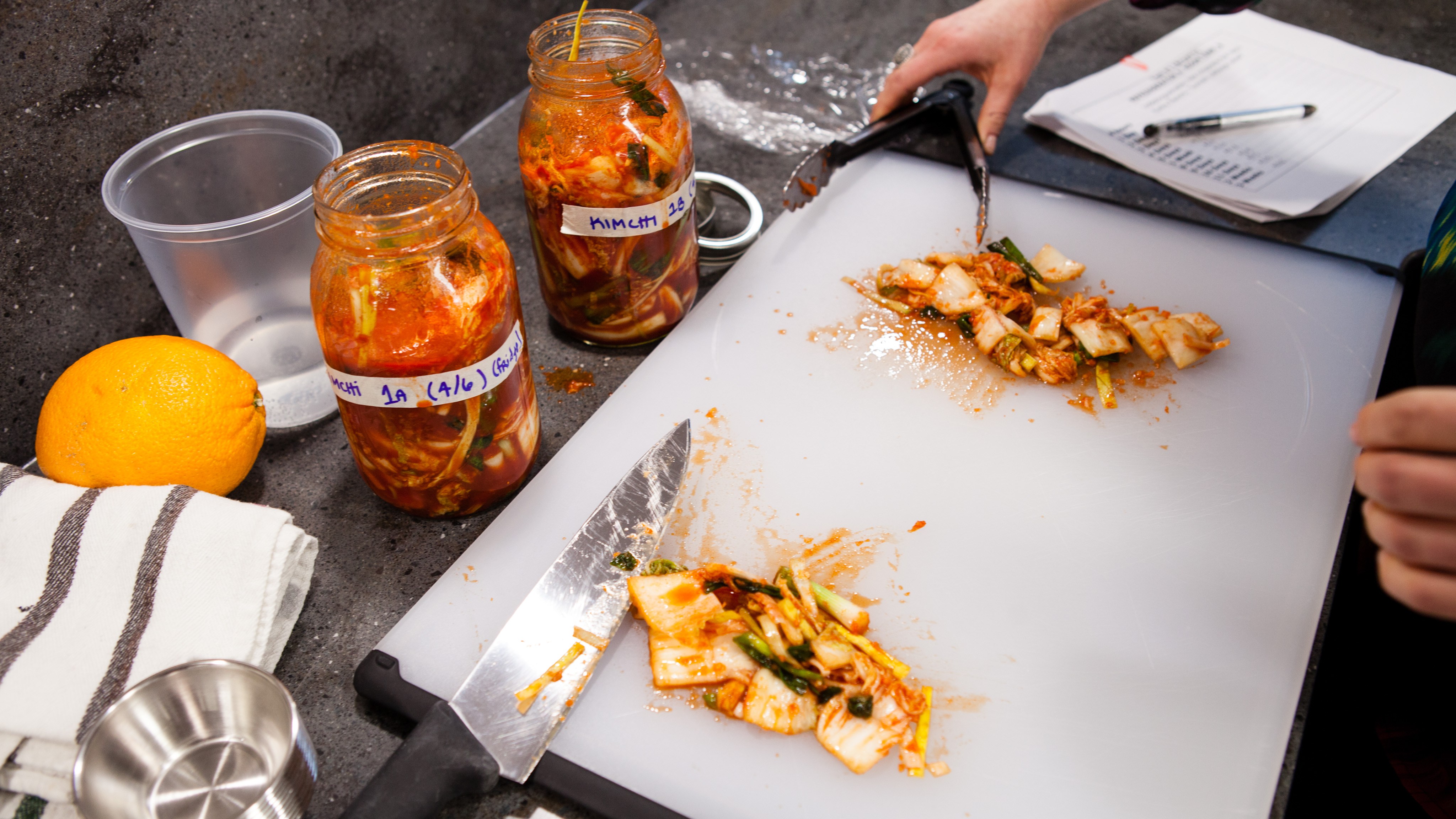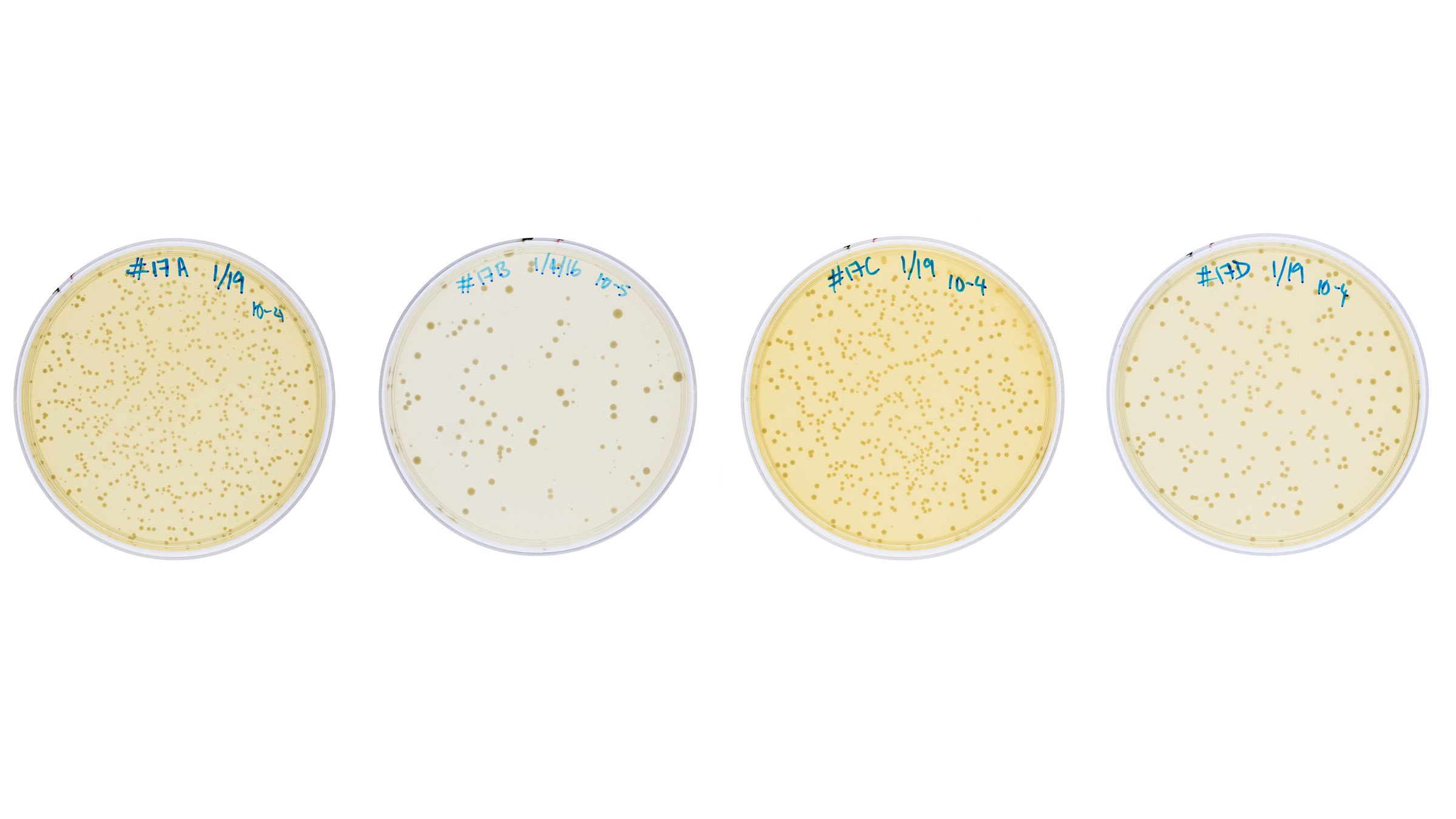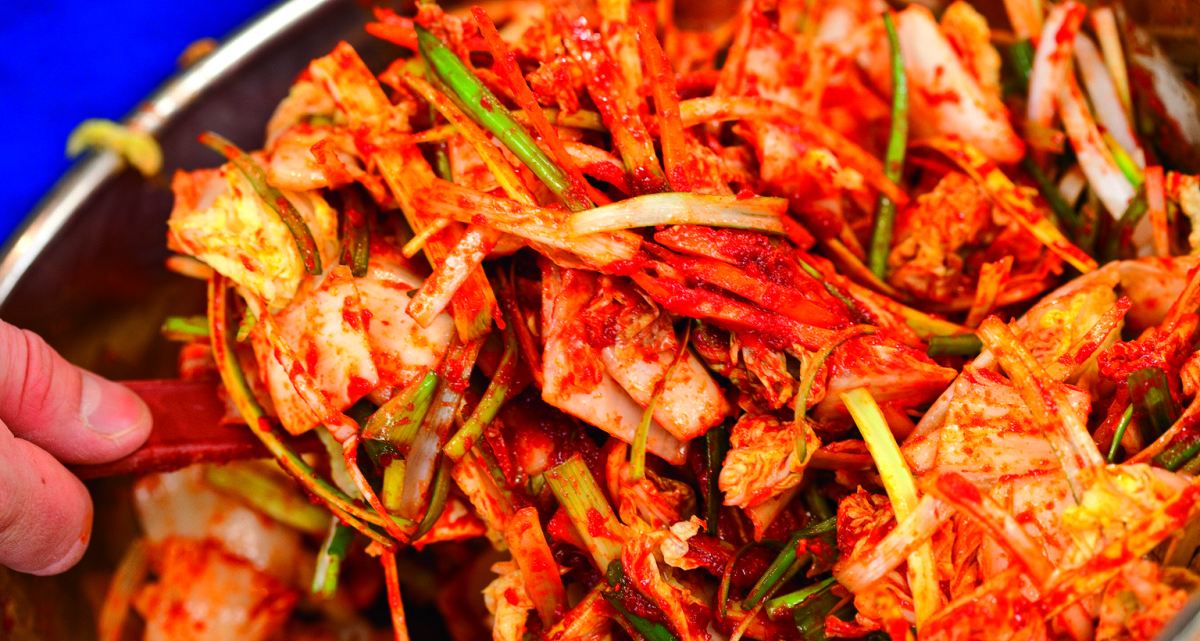Kimchi is a simple Korean pickle, a fermented mash-up of vegetables like napa cabbage and scallions. It’s easy to make. And it’s everywhere: from modest ramen houses to the trendiest of tapas bars. It’s crossing cultural barriers on menus and filling home refrigerators, from the dorm room to your suburban mom’s well-stocked kitchen. Chefs are slapping it on burgers, layering it into grilled “kimcheese” sandwiches, and even sneaking it into your Bloody Mary. But how can something as basic as cabbage, salt, and spices be so buzzworthy? It’s simple: science.
Kimchi relies on fermentation, or the digestion of sugars into acid, gases, or alcohol (don’t worry, your kimchi won’t be boozy). It’s the fermentation process that gives kimchi its trademark effervescence, tang, and delicious funk, harnessing the natural interactions between bacteria and their environment.
Fermentation is a delicate balance of biology and art—the two things that I’m most passionate about. I didn’t always think I’d become a chef. I studied microbiology, ecology, and evolutionary studies in college. My favorite classes were focused on the interaction between species in a given niche environment. I loved learning how different animals face natural challenges, adapt to best survive, and consequently influence each other. While I enjoyed what I was studying, I loved my night job as a line cook even more. I had planned to go to veterinary school after college. But, in the end, my love for food was stronger than my love for puppies. I left the world of Petri dishes behind in exchange for one of sauté pans. When I started developing a recipe for kimchi for the America’s Test Kitchen book Foolproof Preserving, which came out in April 2016, I had no idea those two worlds were about to collide.
To develop my kimchi recipe, I started by salting the cabbage, a traditional step that draws out excess water. (Nobody likes a soggy pickle.) I then added a potent paste of garlic, ginger, Korean chili powder (gochugaru), sugar, fish sauce, and soy sauce to bring out complexity, heat, and a peppery freshness. I kept my vegetable selection simple: napa cabbage, scallions, and carrots. From this point on, the kimchi just needed to ferment, which would happen naturally when left alone in a jar in the kitchen cabinet. So, basically, I was done! Or so I thought.
But my first attempt was . . . gross. After just three days in a kitchen cabinet, the kimchi pickle was bubbling, overly sharp, and mushy. One taster described it as having too much “zing!” and not enough depth, while another described it as having an overpowering cheesy and dirty flavor. (Nobody wants a dirty pickle.)
What was going on? I started to do some research and learned that, traditionally, kimchi is often fermented in cool pits in the ground—a very different setup from my warm kitchen cabinet. Because kimchi relies on an important balance of salt and a type of bacteria called lactobacilli for preservation, I needed to create the ideal home for these bacteria to thrive. These guys are facultative anaerobes, meaning they can survive both in the presence and absence of oxygen. Either way, they create lactic acid as a by-product of their digestion, which creates an acidic environment, lowering the pH (the measurement of how acidic, neutral, or alkaline something is) and preserving (or pickling) the cabbage. The lactobacilli also make carbon dioxide (which results in the bubbly zing) and create flavorful compounds.
Clearly, lactobacilli’s work is important, and this is why salt is so key. Salt prohibits the growth of unwanted bacteria, giving our beneficial buddies, who are largely salt tolerant, enough time to dominate and pickle the vegetables. But adjusting the salt in my kimchi mixture wasn’t enough to get the texture and flavor I wanted. I decided to tackle the other variable at hand: temperature.

I wasn’t surprised to learn that temperature affects how quickly the bacteria digest and ferment their available food. But I wanted to understand the relationship better so I set up an experiment. I mixed up four identical batches of my in-progress kimchi recipe, packed them into ½-gallon glass jars, and stored them at four different temperatures: 39 degrees Fahrenheit (3.0 degrees Celsius; in the refrigerator), 50 degrees Fahrenheit (10 degrees Celsius; in a wine cooler in my office), 65 degrees Fahrenheit (18.3 degrees Celsius; in a second wine cooler in my office), and 70 degrees Fahrenheit (21.1 degrees Celsius; in my boss’s air-conditioned office). It goes without saying: I have very understanding office mates.
The kimchi fermented in the refrigerator at 39 degrees for 22 days had crisp cabbage, a thin, watery brine, and a one-dimensional, fishy aroma. But after just one week, mold began to grow over the top of the brine in some jars. Due to the cool temperature, this kimchi’s fermentation by lacto-bacilli progressed very slowly, meaning it didn’t become acidic quickly enough, giving potentially harmful bacteria and mold the opportunity to take over.
The batch fermented at 50 degrees was nearly as crisp as the 39-degree sample, with a slightly more complex, funky flavor that tasters described as pleasantly cheesy and buttery. It had a slightly viscous brine, but it still took upwards of two weeks to reach what we considered to be the ideal level of fermentation.
Tasters preferred the kimchi fermented at 65 degrees. While slightly softer than the 50-degree sample, it still retained a fresh crunch. At just nine days old, this pickle featured a saucy, slightly thickened brine and the most balanced mix of bright acidity, rich cheesy flavors, and pleasant, subtle fishy notes. It had a good body, a slightly fizzy tingle, rich backbone, and complexity.
Lastly, the batch fermented at 70 degrees was ready after only six days. But it was too effervescent, on the verge of mushy, and tasted sharp and overly funky. No thanks.
My results made sense, for the most part. Warmer temperatures promote faster fermentation; lactobacilli living at 70 degrees are very active and produce a lot of carbon dioxide and flavor right away—too much so. Living in a cooler environment, however, meant that they digested the available cabbage more slowly. But the kimchi fermented at 50 and 65 degrees both had complex flavors. Did this simply mean that the bacteria at those temperatures had the time necessary to develop more flavor compounds? If that was the case, then why did tasters prefer the kimchi fermented at 65 degrees over the 50-degree batch?
It was time to get really nerdy. I thought back to my ecology classes, in which we studied the progression of a species inhabiting a specific, niche environment. In these environments, one isolated species is never alone. It shares the environment with other life, whether parasites, prey, predators, symbiotic populations, or competitors fighting to use the same necessary resources for survival. Could this be happening in my kimchi jars? Were there multiple players influencing the fermentation of my cabbage? With a little more digging, I learned that existing research on vegetable fermentation has shown that a type of bacteria called Leuconostoc dominate early on in the fermentation process, dropping the pH of the fermenting vegetable and decreasing oxygen available in the environment. This altered environment then favors the growth of different bacteria: the Lactobacillus species.

I sent samples of my kimchi, all the same age of nine days old, to Assistant Professor Ben Wolfe the Tufts University Biology Department for analysis of their respective bacterial compositions. The results suggested that this exact progression was either in the midst of taking place or had already taken place in my samples. The 39-degree sample contained almost entirely Leuconostoc species, while the 50-degree sample was a mixture of both Leuconostoc species and Lactobacillus species. The 65-degree and 70-degree batches were composed almost entirely of Lactobacillus species by the time they were analyzed.
When my brain was done exploding and my taste buds recuperated from my absurd intake of Korean chile powder, I sat down to mentally process what I had just learned. Different temperatures are ideal for different kinds of bacteria, which become the dominant microbe at work when the ferment reaches its ideal temperature. Each microbial community develops different by-products, and therefore different flavors. So, by controlling the temperature and therefore the environment in which my kimchi was fermenting, I could essentially control which bacteria survived and flourished. Meanwhile, other not-so-fortunate bacteria lost out on their cherished, limited resource (cabbage). The temperature of fermentation determines both the assortment of bacteria present and the speed at which these guys do their work. As the lab results suggested, Leuconostoc stay active for much longer at cooler temperatures, leading to a milder flavor. As I increased the temperature, so too did the presence of Lactobacillus species that produce more complex flavors.
Because temperature dictates the speed at which fermentation progresses, it also determines how long each type of bacteria is present, before the environment subsequently changes into what is ideal for another bacteria species to thrive. But what does this mean for my recipe? I had found that the ideal environment for lactic acid–producing bacteria to thrive and create the perfect balance of “funky” flavors is somewhere between 50 and 70 degrees. The ultimate sweet spot, 65 degrees, provides the optimal environment for kimchi with a thickened, tangy brine, a balance of mellow fishy and cheesy notes, a touch of fizz, crunchy cabbage, and well-rounded flavor. Now, go check your thermostat and make some kimchi of your own!
Photography by Steve Klise, Anthony Tieuli, and Daniel J. van Ackere
